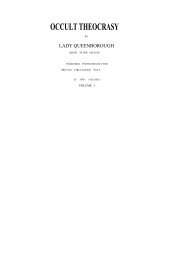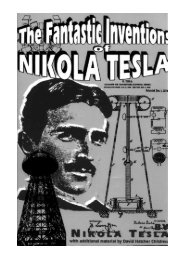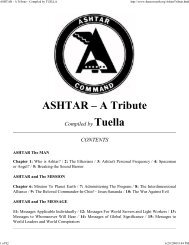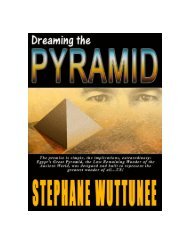the fantastic inventions of nikola tesla - Exopolitics Hong Kong
the fantastic inventions of nikola tesla - Exopolitics Hong Kong
the fantastic inventions of nikola tesla - Exopolitics Hong Kong
Create successful ePaper yourself
Turn your PDF publications into a flip-book with our unique Google optimized e-Paper software.
It consists <strong>of</strong> a number <strong>of</strong> brass pieces c c (Fig. 6), each <strong>of</strong> which comprises a spherical middle portion m with an<br />
extension e below— which is merely used to fasten <strong>the</strong> piece in a la<strong>the</strong> when polishing up <strong>the</strong> discharging<br />
surface—and a column above, which consists <strong>of</strong> a knurled flange f surmounted by a threaded stem l carrying a nut<br />
n, by means <strong>of</strong> which a wire is fastened to <strong>the</strong> column. The flange/ conveniently serves for holding <strong>the</strong> brass piece<br />
when fastening <strong>the</strong> wire, and also for turning it in any position when it becomes necessary to present a fresh<br />
discharging surface. Two stout strips <strong>of</strong> hard rubber R R, with planed grooves g g (Fig- 7) to fit <strong>the</strong> middle portion<br />
<strong>of</strong> <strong>the</strong> pieces c c, serve to clamp <strong>the</strong> latter and hold <strong>the</strong>m firmly in position by means <strong>of</strong> two bolts C C (<strong>of</strong> which<br />
only one is shown) passing through <strong>the</strong> ends <strong>of</strong> <strong>the</strong> strips.<br />
FIG. 7.—DISCHARGER WITH MULTIPLE GAPS.<br />
In <strong>the</strong> use <strong>of</strong> this kind <strong>of</strong> discharger I have found three principal advantages over <strong>the</strong> ordinary form. First, <strong>the</strong><br />
dielectric strength <strong>of</strong> a given total width <strong>of</strong> air space is greater when a great many small air gaps are used instead <strong>of</strong><br />
one, which permits <strong>of</strong> working with a smaller length <strong>of</strong> air gap, and that means smaller loss and less deterioration<br />
<strong>of</strong> <strong>the</strong> metal; secondly by reason <strong>of</strong> splitting <strong>the</strong> arc up into smaller arcs, <strong>the</strong> polished surfaces are made to last<br />
much longer; and, thirdly, <strong>the</strong> apparatus affords some gauge in <strong>the</strong> experiments. I usually set <strong>the</strong> pieces by-putting<br />
between <strong>the</strong>m sheets <strong>of</strong> uniform thickness at a certain very small distance which is known from <strong>the</strong> experiments <strong>of</strong><br />
Sir William Thomson to require a certain electromotive force to be bridged by <strong>the</strong> spark.<br />
It should, <strong>of</strong> course, be remembered that <strong>the</strong> sparking distance is much diminished as <strong>the</strong> frequency is increased. By<br />
taking any number <strong>of</strong> spaces <strong>the</strong> experimenter has a rough idea <strong>of</strong> <strong>the</strong> electromotive force, and he finds it easier to<br />
repeat an experiment, as he has not <strong>the</strong> trouble <strong>of</strong> setting <strong>the</strong> knobs again and again. With this kind <strong>of</strong> discharger I<br />
have been able to maintain an oscillating motion without any spark being visible with <strong>the</strong> naked eye between <strong>the</strong><br />
knobs, and <strong>the</strong>y would not show a very appreciable rise in temperature. This form <strong>of</strong> discharge also lends itself to<br />
many arrangements <strong>of</strong> condensers and circuits which are <strong>of</strong>ten very convenient and time-saving. I have used it<br />
preferably in a disposition similar to that indicated in Fig. 2, when <strong>the</strong> currents forming <strong>the</strong> arc are small.<br />
I may here mention that I have also used dischargers with single or multiple air gaps, in which <strong>the</strong> discharge<br />
surfaces were rotated with great speed. No particular advantage was, however, gained by this method, except in<br />
cases where <strong>the</strong> currents from <strong>the</strong> condenser were large and <strong>the</strong> keeping cool <strong>of</strong> <strong>the</strong> surfaces was necessary, and in<br />
cases when, <strong>the</strong> discharge not being oscillating <strong>of</strong> itself, <strong>the</strong> arc as soon as established was broken by <strong>the</strong> air<br />
current, thus starting <strong>the</strong> vibration at intervals in rapid succession. I have also used mechanical interrupters in many<br />
ways. To avoid <strong>the</strong> difficulties with frictional contacts, <strong>the</strong> preferred plan adopted was to establish <strong>the</strong> arc and<br />
rotate through it at great speed a rim <strong>of</strong> mica provided with many holes and fastened to a steel plate. It is<br />
understood, <strong>of</strong> course, that <strong>the</strong> employment <strong>of</strong> a magnet, air current, or o<strong>the</strong>r interrupter, produces an effect worth<br />
noticing, unless <strong>the</strong> self-induction, capacity and resistance are so related that <strong>the</strong>re are oscillations set up upon each<br />
interruption.<br />
I will now endeavor to show you some <strong>of</strong> <strong>the</strong> most noteworthy <strong>of</strong> <strong>the</strong>se discharge phenomena.<br />
I have stretched across <strong>the</strong> room two ordinary cotton covered wires, each about 7 metres in length. They are<br />
supported on insulating cords at a distance <strong>of</strong> about 30 centimetres. I attach now to each <strong>of</strong> <strong>the</strong> terminals <strong>of</strong> <strong>the</strong> coil<br />
one <strong>of</strong> <strong>the</strong> wires and set <strong>the</strong> coil in action. Upon turning <strong>the</strong> lights <strong>of</strong>f in <strong>the</strong> room you see <strong>the</strong> wires strongly<br />
illuminated by <strong>the</strong> streams issuing abundantly from <strong>the</strong>ir whole surface in spite <strong>of</strong> <strong>the</strong> cotton covering, which may<br />
even be very thick. When <strong>the</strong> experiment is performed under good conditions, <strong>the</strong> light from <strong>the</strong> wires is sufficiently<br />
intense to allow distinguishing <strong>the</strong> objects in a room. To produce <strong>the</strong> best result it is, <strong>of</strong> course, necessary to<br />
adjust carefully <strong>the</strong> capacity <strong>of</strong> <strong>the</strong> jars, <strong>the</strong> arc between <strong>the</strong> knobs and <strong>the</strong> length <strong>of</strong> <strong>the</strong> wires. My experience is<br />
that calculation <strong>of</strong> <strong>the</strong> length <strong>of</strong> <strong>the</strong> wires leads, in such case, to no result whatever. The experimenter will do best









